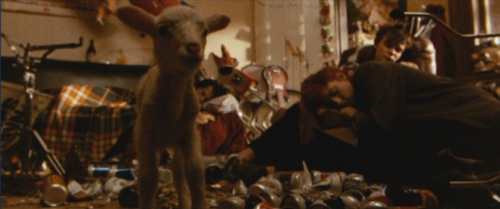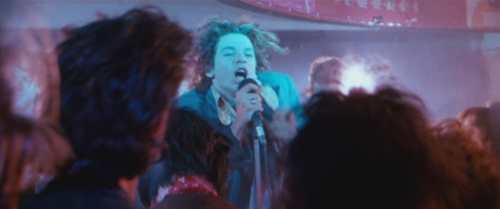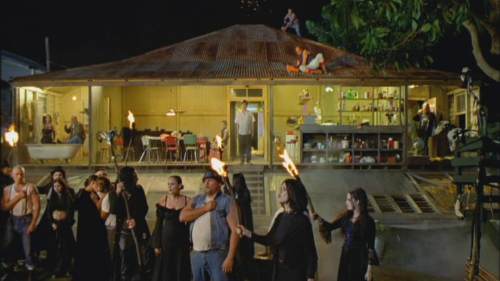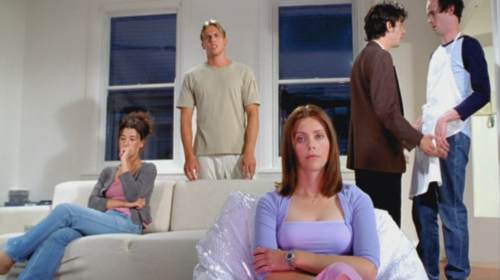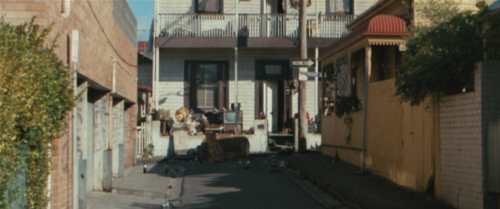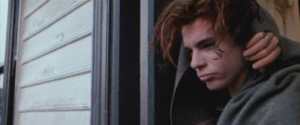 Dogs in Space (Richard Lowenstein, 1986) and
Dogs in Space (Richard Lowenstein, 1986) and
We’re Livin’ on Dog Food (Richard Lowenstein, 2009) and
He Died With a Felafel in His Hand (Richard Lowenstein, 2001)
Movies are time capsules. Inner city suburbs of Melbourne such as Fitzroy, Brunswick, Carlton, Richmond, St. Kilda and Collingwood are now largely gentrified, filled with young professionals and with only a modicum of their former grunginess preserved; much of the shabbiness that remains – pokey cafes, tatty pubs – is artfully preserved to maintain an inner city chic. Yet the older, scruffier inner Melbourne is still there in all its glory in films like The Club, Malcolm, Death in Brunswick and Monkey Grip. Amongst this group, no film stands as deliberately as a time capsule of a place and an era as Richard Lowenstein’s cult classic Dogs in Space, from 1986, which has now been released on DVD after playing at the 2009 Melbourne International Film Festival.
The film chronicles life in a Richmond share house in the late 1970s, centering on the spaced-out musician Sam (Michael Hutchence) and his easygoing girlfriend Anna (Saskia Post). Virtually plotless, it depicts the parties and conflicts in and around the house as various different subcultures (punks, hippies, and one unfortunate uni student) co-exist. Many of the housemates are in underground punk bands, and the film was inspired by real-life events in the Melbourne post-punk music scene. As Lowenstein’s subsequent documentary We’re Livin’ on Dog Food (which also played at the festival and which is included on the Dogs in Space DVD) makes clear, the timing of Dogs in Space was at once far enough away from the real events that it already had a nostalgic air, and yet close enough that the film could get a documentary-like feel through the participation of some of the real people and bands.
In capturing that inner-Melbourne share house experience, Dogs in Space documents a lifestyle that will be familiar, in a milder form, to many Melbournians. Presumably other cities will have their local equivalents, and even in Melbourne there are many variations on the basic template of young inner-urban lifestyles. (Four years earlier, Ken Cameron’s film of Helen Garner’s novel Monkey Grip had depicted the intellectual / leftist / university-oriented variation on the culture.) Anyone who has spent much of their twenties living in or hanging around share houses will relate to the film’s depiction of an idealised version of that lifestyle, and that no doubt accounts for a large part of the continued cult following of Dogs in Space. Perhaps the crowd that were the inspiration for the film did indeed live their lives in the state of non-stop partying depicted in the film; most share house dwellers presumably led more mundane lives. Yet the film captures the way people would like to believe they lived, without the realities of work or study breaking up the partying, drinking or veging out in front of the television. (“Remember that time we had a party and ended up setting fire to the TV in the middle of the street?”) That’s what’s inspired about the film’s near plotlessness: just as people might like to remember the good times of their younger years as uninterrupted by everyday reality, Dogs in Space serves up its hedonism largely unsullied by plot.
What Lowenstein does so well within his loose framework is give a fun but aimless existence the epic treatment. The house is the height of slob chic, so impossibly dirty and litter-strewn that you know the people living there are really living. It’s the ultimate, mythologised share house, where the parties are so crazy that livestock end up wandering the hallways. Yet Lowenstein doesn’t go for a low budget approach to this low budget lifestyle. Instead he and his cinematographer, Andrew de Groot, use a widescreen format and slick, gliding camerawork to make the house and its inhabitants look like a million misspent dollars.
It fits into the scheme of the film, then, that the shabby musician is played by the real-life rock star Hutchence. This remains the best known of the limited film work Hutchence undertook before his death in 1997, and it suggests he could have built a body of good work had he focussed more on acting. We’re Livin’ on Dog Food includes footage from during the shoot in which he chats with the model for his character, musician Sam Sejavka, and Hutchence’s channelling of Sejavka’s mannerisms and appearance is quite uncanny. More importantly, he brings star power to the role that helps to offset the aimlessness and withdrawn quality of the film’s version of Sam. Even more important to the film, though, is Saskia Post as Anna, the long-suffering girlfriend who puts up with the drug-addled Sam long after she should know better. Post gives the character a wide-eyed naivety that makes you sympathise with her one-sided devotion; this is vital, as her haplessness could easily have become infuriating.
Dogs in Space has another implicit ambition, though, beyond chronicling the share house lifestyle and the personal story of Sam and Anna. By specifying a particular time period, and then and using many of the real songs and bands from that time period in the film, it stakes a claim to depict a more important cultural moment. Anyone who has been in, or known people in, that share house culture will be able to map out a social network that existed around a share house (or a group of them), but musicians can go further and claim that informal network is a scene. In this case it is what the Melbourne International Film Festival programmers called the “Melbourne post-punk scene” for a major retrospective at the 2009 festival. Dogs in Space and We’re Livin’ on Dog Food were the centrepieces of that retrospective and were left – fairly or unfairly – to do the heavy lifting of justifying that such a respectful treatment.
For all the grandeur of its grunginess and its self-conscious mythologising, Dogs in Space itself is such an exuberant and unpretentious exercise that it retains its appeal even in such a context. It helps, of course, that the film is the most enduring cultural artefact to emerge from the scene. We’re Livin’ on Dog Food, however, is a curious exercise. Comprising interviews with various participants in both the post-punk scene and the making of Dogs in Space, interspersed with archival footage, it works hard to talk up the importance of the era. The participants take the mythologising seen in Dogs in Space itself and make it even more nostalgic: the overwhelming subtext of most interviews is gee, that was a crazy and intense time. But that isn’t a strong way to make a claim for any enduring cultural significance or impact, and the film struggles with the fact that it is inherently hard for the middle-aged to come across sympathetically when they talk fondly of their exuberant youth. In her interview for the film fashion designer Alannah Hill, who had a small role in Dogs in Space, epitomises the unfortunate inter-generational blind spot at work:
There’s been nothing really like it since… there really hasn’t. And even though, you know, I meet young people now – I’ve got millions of them working for me – and I try to talk to them about subculture and some sort of little club or something that they’ve got going. And nothing seems the same as the punk era. Nothing.
Well, thanks, Grandma. You can put that statement in the mouth of the pretty much any generation in their middle-age: replace the word “punk” with “rock and roll” or “hip hop” or whatever to slide it back and forth in time. You can only imagine what some of the furious, disillusioned punk rockers of the 70s would have made of such complacent dismissal of their own attempts at transgression by their own elders.
To be fair, other participants in Lowenstein’s retrospective are clearer in their perspective: many are frank in their assessment of punk as movement that burnt out without really changing anything, and musician and composer Ollie Olsen states that he is more nostalgic for Dogs in Space itself than the times depicted in it. A similar duality is built into We’re Livin’ on Dog Food: for all its focus on the post-punk scene, is also a good deal of time spent on the production of Dogs in Space, and on the involvement of Michael Hutchence in particular. It’s understandable that there is interest in Hutchence given his star status and the tragic trajectory of his life, but he wasn’t really part of the cultural moment being discussed, and the focus on him dilutes the power of the social history somewhat.
If this all sounds overly dismissive of the particular subculture explored in the two films, then perhaps it is worth considering the glass-half-full version of the same basic observation: if the post-punk subculture seems nothing too special, it’s because the Melbourne of Dogs in Space fostered so many similar creative communities. That’s why Dogs in Space is so much more satisfying as a chronicle of a particular lifestyle: when these vibrant inner suburbs were still affordable for a wide cross-section of the population, they were cradles for an enormous variety of creative endeavour. Those suburbs are now being loved to death, with their attractiveness meaning they are now populated by more affluent professionals – like myself – whose presence then squeezes out the artists, students, immigrants, and assorted riff-raff whose presence contributed so much to the appeal of the areas in the first place. The knowledge that there are precious few share houses full of young people left in the parts of Richmond where Dogs in Space was shot contributes to the elegiac sense hanging over both films. If it already seemed like a bygone age in 1986 when Dogs in Space was made, it seemed even further gone in 2009 when Lowenstein made We’re Livin’ on Dog Food.
Yet Lowenstein had already made an apt postscript to Dogs in Space with He Died with a Felafel in His Hand in 2001. Felafel is based on John Birmingham’s book of the same name, a loosely plotted excursion through various share house horror stories. Birmingham’s book, originally published in 1994, is essentially a compilation of outrageous share house moments – seemingly sourced or exaggerated from real incidents – that mines the personality clashes, filthiness, and crazy behaviour for comic material. Lowenstein takes a few characters and incidents from the book and slightly strengthens the narrative, following aspiring author Danny (Noah Taylor) through three share houses in different cities: first in Brisbane, then in Melbourne, then Sydney. The tone is broader than Dogs in Space, with a stronger focus on escalations of comic mayhem. The conclusion of the Brisbane sequence in particular, as the house is literally sawn open (Steamboat Bill Jr. style), while neo-Nazis battle radical feminists in the backyard, is strongly reminiscent of the broad tone Birmingham’s writing.
Yet the film nevertheless makes an apt companion piece to Lowenstein’s earlier film. Taylor had appeared in that film in a tiny role in a party scene, and here he plays Danny with a deliberate air of exhaustion that evokes many years of shifting from house to house. In interviews at the time of release, Taylor suggested his approach to the role was meant to hint at the calm amidst chaos that Buster Keaton used to project in his comedies, although in fact Taylor is not as impassive as that here. What he does convey, though, is the sense of being trapped in a share house experience that won’t end, as he battles to produce some written work that will help him to escape the insane housemates and growing list of bad debts. We are told the three houses we see in the film are houses 47, 48, and 49 in the chronology of his life in share houses; the sense of this time passing is built into the character of Danny to such an extent that you feel he may actually be the young partygoer Taylor played in Dogs in Space’s late 1970s milieu.
As in Dogs in Space and We’re Livin’ on Dog Food, an untimely death adds weight and shape to the story being told. Yet unlike those films, the character or person who dies is so sketchily introduced that there is little real sense of loss. What really gives the film some much needed substance is its examination of what happens to Danny when he has outgrown his share house life but not managed to escape it. This is embedded in Lowenstein’s most important addition to Birmingham’s book: the narrative structure of Danny’s lifestyle crumbling over the course of the film. The film’s early scenes in Brisbane evoke a share house experience that is recognisable as a tropical variation of that seen in Dogs: a bunch of mates enjoying a life of genteel poverty in a chaotic house. Yet as Danny continues to move, the experience turns less agreeable. The Melbourne to which Danny moves is unrecognisable as the cultural hotspot we saw in Dogs: the house is anonymous, there’s no sense of the city’s cultural life, and it seems always to be raining. By the time Danny reaches Sydney he is sharing a soulless, stark-white apartment in which his yuppie housemates argue incessantly.
Any sense of the share house culture feeding an artistic community is absent. Instead of living amongst musicians, Danny lives in a creative wasteland and is paralysed by writer’s block: when he does finally get his big artistic break, it’s a story for Penthouse. There isn’t even a sense of the share house as a place for a vibrant social networking: people float in and out of Danny’s life, and he struggles to make a true emotional connection with the closest of his housemate friends, Sam (Emily Hamilton). One of Lowenstein’s favourite comic devices, in which he fills a room with a number of characters who are all intent on their own particular obsession and oblivious to all that is around them, neatly defines the disconnected social landscape in which Danny finds himself.
All this helps give the sense that Danny is a relic of a lifestyle that was at one time far more fulfilling, and in this sense, He Died with a Felafel in His Hand anticipates the elegaic tone of We’re Livin’ on Dog Food. The stripping away of the cultural trappings of the share house lifestyle, to the point where it becomes not a shared community but rather a desperate arrangement made by those with nowhere else to go, gives the film a sense of loss more palpable than that conveyed by the rather hastily sketched drug-death subplot. He Died with a Felafel in His Hand presumably suffered in box office terms because the awareness of Dogs in Space had reduced when it was not readily available on home video or DVD, but the downbeat tone of the later film probably also played a part. Despite its more overtly comic book style, at one level it is a more subdued film than its predecessor.
By marking the decline of a broad way of life, rather than a particular cultural moment, He Died with a Felafel in His Hand is, I think truer to the spirit of Dogs in Space than We’re Livin’ on Dog Food. If what is memorable about the era depicted in Dogs in Space is those particular bands, those particular people – as We’re Livin’ on Dog Food often implies – then there’s little reason for the rest of us to watch it. Yet Dogs in Space is actually a link back to something more important and more vital: a way of living and a type of community that is increasingly under threat. You can still find the Dogs in Space house in Richmond with only a little sleuthing, and physically the fabric of the house and street are largely unchanged. Yet it is on film that an older, less genteel and more vibrant version of Richmond lives on.
